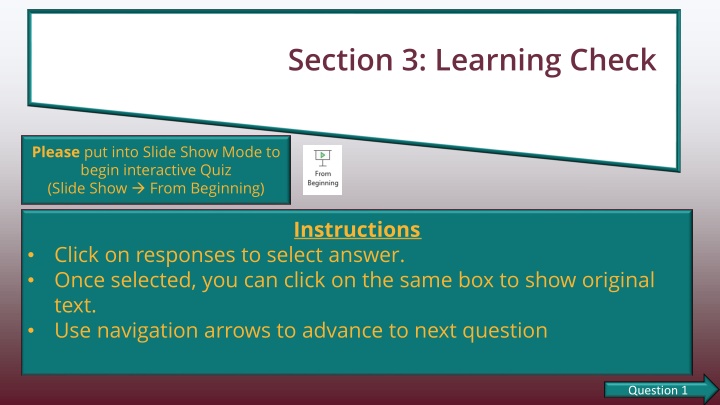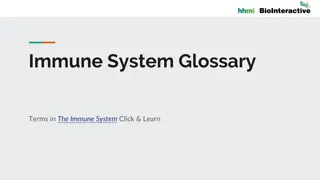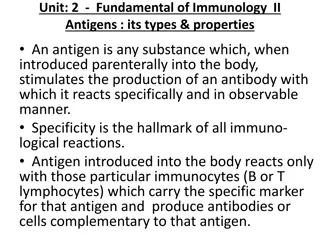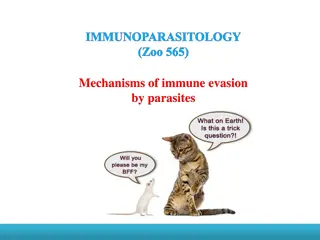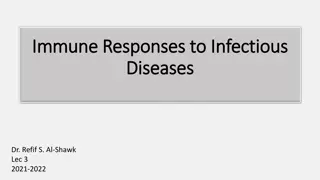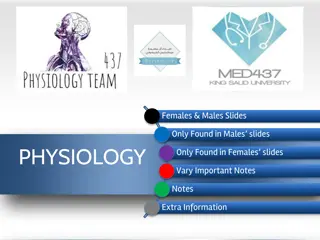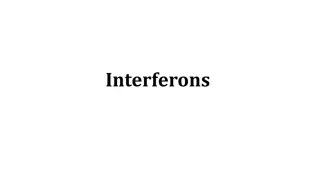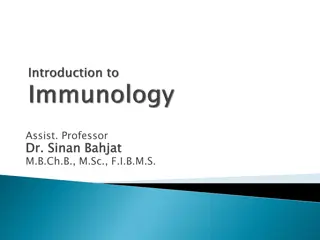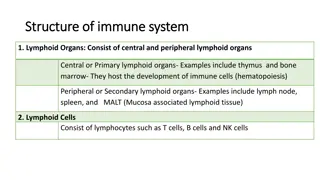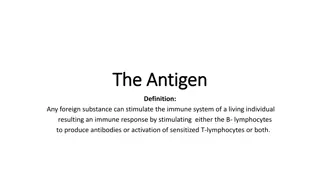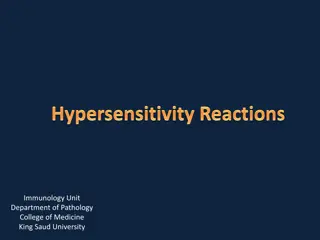Innate Immune Responses Overview
The immune system's innate defenses aim to halt foreign invaders with inherited and nonspecific mechanisms grouped into mechanical, chemical, interferon, natural killer cells, and phagocytosis categories. These defenses featured are tailored to stop diverse threats and include mechanical barriers like mucus and saliva, lysozymes found in bodily fluids, interferons inhibiting viral replication, natural killer cells targeting abnormal cells, and phagocytosis performed by neutrophils and macrophages. Phagocytosis progresses via leukocytosis, margination, diapedesis, chemotaxis, adherence, ingestion, and the eventual formation of phagolysosomes. Inflammation's stages involve increased vasodilation and permeability, resulting in characteristic signs like warmth, redness, pain, and swelling. Various chemicals assist in this process, including histamine and kinins.
Download Presentation

Please find below an Image/Link to download the presentation.
The content on the website is provided AS IS for your information and personal use only. It may not be sold, licensed, or shared on other websites without obtaining consent from the author.If you encounter any issues during the download, it is possible that the publisher has removed the file from their server.
You are allowed to download the files provided on this website for personal or commercial use, subject to the condition that they are used lawfully. All files are the property of their respective owners.
The content on the website is provided AS IS for your information and personal use only. It may not be sold, licensed, or shared on other websites without obtaining consent from the author.
E N D
Presentation Transcript
Section 3: Learning Check Please put into Slide Show Mode to begin interactive Quiz (Slide Show From Beginning) Instructions Click on responses to select answer. Once selected, you can click on the same box to show original text. Use navigation arrows to advance to next question Question 1 Question 1
Knowledge Check True or False: Validity evidence based on internal structure should provide support for the relationship between the test scores and scores on a similar test. 1 This is correct. Validity evidence based on relations to other variables should provide support for the relationship between the test scores and scores on a similar test. This is incorrect. Validity evidence based on relations to other variables should provide support for the relationship between the test scores and scores on a similar test. Please, try again. True False Instructions Next Question Instructions Next Question
Knowledge Check True or False: Validity evidence based on internal structure should provide support for the alignment between the dimension(s) being measured on the test and the intended dimension(s) of the test and the interpretation of test scores. 2 This is incorrect. This type of support represents an evaluation of the dimensionality of the test. This is correct. This type of support represents an evaluation of the dimensionality of the test. True False Previous Question Next Question Previous Question Next Question
Knowledge Check True or False: Validity evidence based on internal structure should provide support for similar functioning of all items on the test for all identifiable subgroups of test takers. 3 This is incorrect. This is known as differential item functioning (DIF) and should be evaluated. This is correct. This is known as differential item functioning (DIF) and should be evaluated. True False Previous Question Next Question Previous Question Next Question
Knowledge Check True or False: Validity evidence based on response processes should provide support for the consistency of scores when there are repeated or multiple testing occasions. 4 This is correct. Validity evidence based on internal structure should provide support for the consistency of scores when there are repeated or multiple testing occasions. This is known as evaluating the reliability. You can learn more about reliability from the Digital Module 01: Reliability in Classical Test Theory. This is incorrect. Validity evidence based on internal structure should provide support for the consistency of scores when there are repeated or multiple testing occasions. This is known as evaluating the reliability. You can learn more about reliability from the Digital Module 01: Reliability in Classical Test Theory. True False Previous Question Next Question Previous Question Next Question
Knowledge Check True or False: Validity evidence based on test content should ensure the test content reflects the construct it is designed to measure. 5 This is correct. The goal of validity evidence based on test content is to provide data to support the appropriate representation of the construct. This is incorrect. The goal of validity evidence based on test content is to provide data to support the appropriate representation of the construct. True False Previous Question Next Question Previous Question Next Question
Knowledge Check True or False: Validity evidence based on test content should ensure the test includes extraneous material to keep it interesting. 6 This is incorrect. Validity evidence based on test content should ensure the test does not include extraneous material to keep it interesting. Anything extraneous included in a test or an item can increase the construct irrelevant variance of the test. Construct irrelevant variance is defined as the inflation or deflation of test scores due to systematic measurement error (i.e., content included that is not necessary and could provide an advantage to certain groups of test takers). This is correct. Validity evidence based on test content should ensure the test does not include extraneous material to keep it interesting. Anything extraneous included in a test or an item can increase the construct irrelevant variance of the test. Construct irrelevant variance is defined as the inflation or deflation of test scores due to systematic measurement error (i.e., content included that is not necessary and could provide an advantage to certain groups of test takers). True False Previous Question Next Question Previous Question Next Question
Knowledge Check True or False: Validity evidence based on test content should ensure the items reflect only the most interesting content standards. 7 This is correct. Validity evidence based on test content should ensure the items reflect all the the content standards that the test claims to measure. If a test is designed to measure a specific construct, but doesn't fully represent the construct, this is known as construct underrepresentation. Construct underrepresentation is defined as a sample of content from a construct that is incomplete and does not fully represent the entire construct. This is incorrect. Validity evidence based on test content should ensure the items reflect all the the content standards that the test claims to measure. If a test is designed to measure a specific construct, but doesn't fully represent the construct, this is known as construct underrepresentation. Construct underrepresentation is defined as a sample of content from a construct that is incomplete and does not fully represent the entire construct. True False Previous Question Next Question Previous Question Next Question
Knowledge Check True or False: Validity evidence based on relations to other variables should ensure the test scores are appropriately related to other measures of the same construct. 8 This is incorrect. Validity evidence based on relations to other variables should ensure the test scores are related to other measures of the same construct. This is also known as concurrent validity. This is correct. Validity evidence based on relations to other variables should ensure the test scores are related to other measures of the same construct. This is also known as concurrent validity. True False Previous Question Next Question Previous Question Next Question
Knowledge Check True or False: If you were to investigate the passing rates across groups of students with different cultural backgrounds, you would be looking for evidence of testing consequences. 9 This is incorrect. Following this line of investigation would result in an analysis of adverse impact and would provide evidence for testing consequences. This is correct. Following this line of investigation would result in an analysis of adverse impact and would provide evidence for testing consequences. True False Previous Question Next Question Previous Question Next Question
Knowledge Check True or False: Validity evidence based on response processes should provide support for the same response processes being applied across different groups of students. 10 This is correct. Validity evidence based on response processes can help us better understand interpretations of test scores. If there is evidence of different response processes being used by different groups of test takers, then the items should be reviewed and/or the experiences of the test takers (depending on the situation) should also be evaluated for violations of fairness. This is incorrect. Validity evidence based on response processes can help us better understand interpretations of test scores. If there is evidence of different response processes being used by different groups of test takers, then the items should be reviewed and/or the experiences of the test takers (depending on the situation) should also be evaluated for violations of fairness. True False Previous Question Next Question Previous Question Next Question
You have reached the end of this learning check Please click anywhere to exit! Lewis, J. & Sireci, S. G.(2022). Validity and educational testing: Purposes and uses of educational tests [Digital ITEMS Module 30]. Educational Measurement: Issues and Practice, 41(4), 81-82. https://doi.org/10.1111/emip.12533 Previous Question Previous Question
